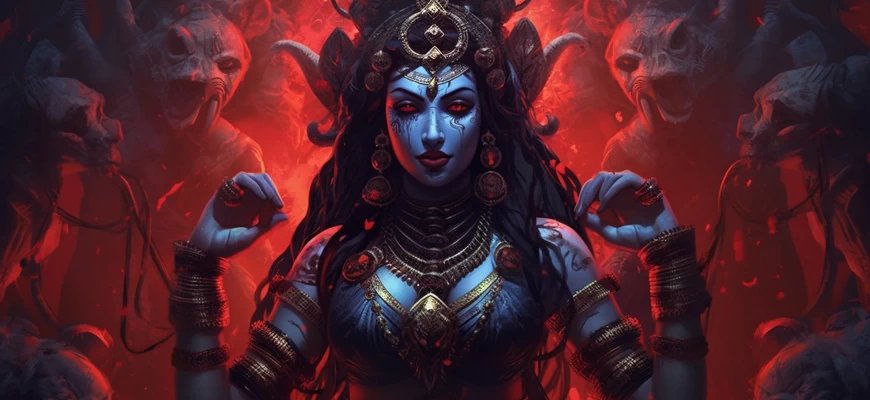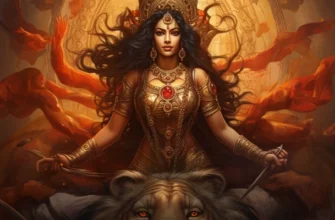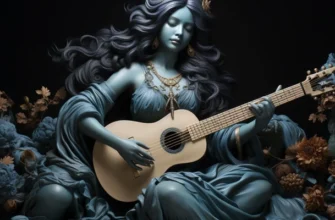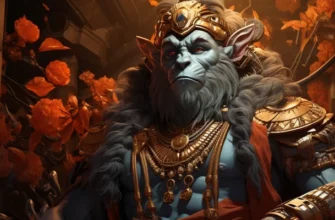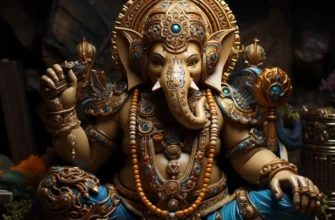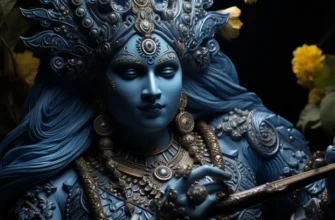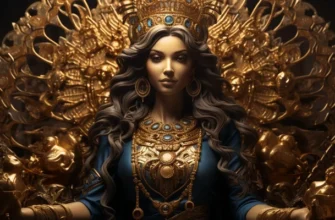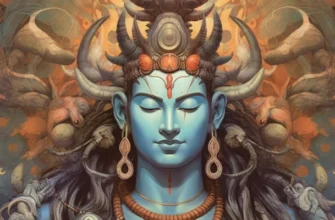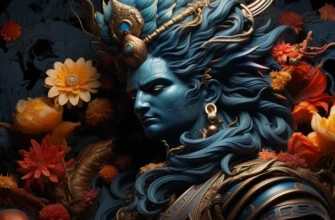The Indian goddess Kali, one of the most prominent figures in Indian mythology, symbolizes power and destruction. Her image is often depicted with her attributes, which include severed heads and a belt of shattered bones. This divine being embodies both fear and protection, which is reflected in modern culture and religious beliefs.
The cult of Kali persists in the modern world through art, literature, and religious practices that reflect the majesty and power of this divine being.
- Historical context of Kali
- Origin and mythological legends
- Creation legends
- Symbolism of Kali
- Attributes of Kali
- Visual representation
- The cult of Kali in the modern world
- Reflections in contemporary culture
- Art and literature
- Religious and socio-cultural beliefs
- Role in modern Indian society
- Beliefs and rituals
- Conclusions
Historical context of Kali
The historical context of the goddess Kali is related to ancient Indian mythology and culture, dating back thousands of years. Kali is recognized as one of the forms of the deity Durga and is one of the main deities of the Tantric tradition. Her cult has been preserved for centuries in different regions of India, and her influence is felt in the religious practices and cultural traditions of this country. The historical context of Kali reflects her importance in ancient and modern Indian culture.
Historically, Kali was first mentioned in texts around the 6th and 7th centuries BC. She was depicted as a goddess of strength, struggle, and war, who was able to destroy evil. Kali’s influence in Indian society has changed throughout history, and she has remained an important figure in religious and cultural practices.
Today, the goddess Kali remains an important part of Indian culture and religion, and her cult is celebrated in numerous festivals and religious rites in India and other regions.
Origin and mythological legends
The goddess Kali is recognized as one of the forms of the deity Durga, who in turn is one of the incarnations of the deity Parvati. Her origin is linked to ancient Indian mythology, where she appears as a symbol of female strength and courage. In various texts, such as the Devi Mahatma and the Markandeya Purana, she appears as a great force that resists evil and protects the world from darkness. Her origin is closely linked to the culture and religious practices of Indian society, where she is of great importance as a symbol of strength and protection.
Creation legends
The legend of the creation of the goddess Kali is associated with one version of mythology. According to this legend, after the demon Raktabij caused a threat to the world with his ability to create new demons with every drop of his blood, the gods were concerned and turned to the great divine power for protection. From the witch’s fireball that resulted from their prayers, the goddess Kali emerged.
Kali was gifted with extraordinary strength and the desire to stop Raktabij. In the battle, she consumed every drop of his blood, thus ending his life. However, her thirst for battle led to bloodshed and created the horrific image of severed heads and exposed tongues that has become a characteristic feature of her image. The legend emphasizes her strength, determination and sacrifice to protect the world from evil.
Legend 1: Fighting the demon Raktabij
In this legend, Kali emerged to stop the demon Raktabij. This demon had the ability to create new demons with every drop of his blood, making him extremely dangerous. Kali came to the rescue, devoured every drop of blood he spilled, thus ending his life. But her thirst for fighting led to bloodshed and gave rise to a horrifying image with wrinkles and an open tongue.
Legend 2: Fighting the demon Shumbha and Nishumbha
This legend tells how Kali fought the demons Shumbha and Nishumbha, who had taken over the heavens and the Earth. In the battle, Kali used her incredible strength and destroyed both demons, establishing peace and harmony in the world.
Legend 3: Destruction of the demon Durgamba
In this legend, Kali destroyed the demon Durgamba, who was terrorizing people and gods. She went out to battle with the demon’s severed heads and ensured peace and security for all the inhabitants of the world.
These legends reflect the role of the goddess Kali as a fighter against evil and protector of the world in Indian mythology.
Symbolism of Kali
The goddess Kali is depicted with severed human heads, symbolizing the destruction of the ego and the enslavement of evil. Her belt, made of broken human bones, emphasizes her dedication to fighting evil. The open tongue in her image indicates the consumption of evil and the destructive power of time. These symbols reflect not only her frightening aspect, but also her power to destroy darkness.
The symbolism and attributes of the goddess Kali include:
- Severed heads symbolizing the destruction of evil and the ego.
- A belt with shattered bones, indicating her strength and power over death.
- An open tongue, reflecting her power and ability to absorb evil.
- Dark leather tone, symbolizing steadfastness and power over time and space.
- Weapons and accessories, such as a sword, trident, or other implements she holds, emphasize her character and strength.
These symbols are important for understanding her role as a divine force that fights evil and restores harmony in the world.
Attributes of Kali
The attributes of the goddess Kali include:
- Black skin color, symbolizing steadfastness and power over time and death.
- Severed human heads, indicating the destruction of evil and victory over enemies.
- A belt with broken bones, symbolizing her power and authority over life and death.
- The sword or trident she holds in her hand, which acts as an instrument for the destruction of evil.
- Her figure can be depicted in a pose that marks her fight against demons. These attributes help to represent her power and importance in fighting evil and restoring harmony.
Visual representation
The visual representation of the goddess Kali is often depicted as a monstrous woman with wrinkles standing in her courtyard with severed heads and a belt of shattered bones. Her skin is black, symbolizing steadfastness and power over time. She may also have icy or bloody eyes, reflecting her power over life and death. This visual representation emphasizes her terrifying aspect and power, which absorbs all the destructive power of time and evil.
The symbolism of the goddess Kali has a deep meaning in Indian culture. The severed heads symbolize the destruction of the ego and the complete subjugation of evil. The belt with broken bones indicates her strength and power over death. The open tongue represents her power to absorb evil and restore balance. These symbols emphasize her role in destroying darkness and restoring harmony in the world.
The cult of Kali in the modern world
The cult of the goddess Kali continues to exist in the modern world, especially in India and other countries where Hinduism and Indian culture are influential. In the modern world, Kali is reflected through religious rituals, festivals, and prayers dedicated to her. A few important aspects of Kali worship in the modern world include:
- Festivals: Festivals, such as Durga Puja and Kali Puja, are celebrated in honor of the goddess Kali and include religious rituals, worship, and prayers.
- Specialized temples: There are temples dedicated to the goddess Kali where worshippers gather for worship and rituals.
- Art and cultural influence: The image of Kali is found in Indian art, literature, music, and cinema. She has become a symbol of female strength and courage in contemporary Indian culture.
- Spiritual development: Many people seek spiritual development and discovery through the worship of the goddess Kali, discovering her aspects of strength, sacrifice, and protection.
- Use of symbolism: The image of Kali and her symbols are used to celebrate strength and indestructibility in contemporary societal contexts.
In today’s world, the cult of Kali remains an important part of Indian religious and cultural heritage, inspiring believers to develop spiritually and protect themselves from evil.
Reflections in contemporary culture
The goddess Kali continues to be an important figure in contemporary culture, both in India and around the world. She is reflected in various aspects of modern life through art, literature, film, music, and fashion. A few ways in which she is reflected in contemporary culture include:
- Literature and art: Various literary works and artistic works use the image of Kali to express strength, indestructibility, and protection.
- Film industry: Films often use Kali imagery to embody feminine strength and courage, which inspires viewers.
- Music: She also appears in musical works as a symbol of strength and liberation.
- Fashion: The image of Kali can be used in fashion trends to reflect strength, will, and independence.
- Other cultural expressions: The image of Kali appears in various other cultural expressions, such as television, cartoons, and social media, emphasizing the importance of her symbolic significance to the modern world.
The depiction of the goddess Kali in contemporary culture helps to maintain and reproduce her role as a symbol of strength, courage, and protection in the modern world.
Art and literature
In art and literature, the goddess Kali plays an important role as a symbol of strength, steadfastness, and protection. She has inspired numerous artists and writers to create works of art and literature that reflect her greatness and symbolic significance. Some examples:
- Painting: The goddess Kali is often depicted in paintings by artists in a variety of ways, including her fighting demons, devouring power, or in displays of feminine grace. Her images can evoke a sense of courage and majesty.
- Literature: Literary works devoted to the goddess Kali reveal her role in fighting evil and protecting the world. They may describe her mythological exploits and her importance in religious texts.
- Poetry: Many poets use the image of Kali as a source of inspiration for their poems and poems in which they express gratitude and faith in her power.
- Novels and short stories: Stories involving the goddess Kali can be part of Indian literature, as well as fantasy novels and short stories where her image is used to create interesting plots.
The goddess Kali remains an important source of inspiration for artists and writers, as reflected in various works of art and literature that emphasize her symbolic significance.
The goddess Kali has a significant influence on popular culture, appearing in various aspects of modern life. She has become an integral part of art, literature, film, music, and fashion, reflecting the strength and indestructibility of female identity. Its symbolism is often used as an embodiment of courage and bravery in the modern world.
Religious and socio-cultural beliefs
The religious and socio-cultural beliefs associated with the goddess Kali include a variety of aspects that are deepened and transmitted through religious rites, festivals, and traditions. Some of them are:
- Devotion and worship: Believers honor the goddess Kali through religious rituals, prayers, and various forms of devotion, expressing their belief in her power and protective properties.
- Religious festivals: Festivals dedicated to the goddess Kali are held with a variety of rituals, songs and dances that emphasize her greatness and importance in a religious context.
- Socio-cultural significance: The image of Kali influences socio-cultural beliefs, testifying to the importance of female strength, will and courage in Indian society and far beyond.
- Traditions and rituals: Believers observe traditions associated with the goddess Kali, such as worshiping in temples, performing rituals, and participating in celebrations that emphasize her importance in their religious and cultural life.
These religious and socio-cultural beliefs are deeply rooted in Indian culture and society, reflecting the importance of Goddess Kali in the lives of believers and society at large.
The socio-cultural beliefs associated with the goddess Kali emphasize her role in solving problems, preserving harmony, and fighting evil in the modern world.
Role in modern Indian society
In contemporary Indian society, Goddess Kali plays an important role as a symbol of strength, will and courage, which is reflected in various aspects of cultural, religious and social life. Some of the roles of Goddess Kali in contemporary Indian society include:
- Female emancipation: The image of Kali inspires women to be empowered and liberated, encouraging them to be strong and independent in the modern world.
- Social justice: Believers see Kali as a protector of the weak and a fighter against injustice, which influences their views on justice and equality in society.
- Spiritual development: She is an object of worship and meditation for those seeking inner peace, strength, and spiritual enlightenment.
- Symbol of struggle: The image of Kali serves as a source of inspiration for those who fight for justice and truth in society, giving strength and confidence in their actions.
- Preservation of cultural heritage: The cult of Kali helps to preserve and pass on the traditions, arts and values of Indian culture to future generations.
The goddess Kali remains an important symbol for Indian society, influencing its cultural, religious and social aspects, as well as encouraging people to develop spiritually and engage in social activism. Her cult and rituals are an integral part of religious life, as well as a source of inspiration for society as a whole. She serves as an example of female power and defines the constant need for justice and the destruction of evil in modern Indian society.
Beliefs and rituals
The beliefs and rituals associated with the goddess Kali are an important part of Indian religious and cultural heritage. Some of these beliefs and rituals include:
- Worship in temples: Believers make pilgrimages to temples dedicated to Goddess Kali where they make offerings, pray, and perform various rituals.
- Festivals: Festivals such as Kali Puja and Durga Puja are celebrated with special religious observances, songs, dances and other rituals honoring Goddess Kali.
- Sacrifices: In some rituals, devotees offer offerings to Goddess Kali, such as flowers, fruits, candles, and other symbolic objects.
- Meditation and prayer: Believers perform meditation practices and prayers to find spiritual peace and connection with the energy of the goddess Kali.
- Dancing and performing special rituals: Some rituals involve dancing and performing special rites to reflect the power and majesty of the goddess Kali.
These beliefs and rituals are important to believers because they help to deepen their connection to the goddess Kali and to celebrate her importance in their spiritual lives.
Conclusions
Depicted as a symbol of strength, courage, and protection, Goddess Kali plays an important role in Indian culture and religion. Her image is reflected in various aspects of social life, including art, literature, religious rituals, and festivals. Through her power and majesty, she inspires believers to spiritual development, social activism, and the preservation of cultural heritage. Her symbolism and attributes emphasize her role in fighting evil and restoring harmony in the world, providing an important context for understanding her essence and cultic significance.
In today’s world, the goddess Kali stands as a symbol of feminine strength, courage, and protection. Her image and symbolism retain significance in both religious and cultural contexts, emphasizing the importance of devotion, fighting evil, and restoring harmony. Her cult and beliefs continue to exist as a source of inspiration and strength for contemporary Indian society, reflecting the important role of women in the modern world.
